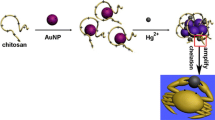Abstract
We have obtained a kind of simple and highly effective method for detection of calcium ions based on glutathione functionalized gold nanoparticles (GSH-GNPs) in this article. The GSH-GNPs can be induced to aggregate immediately in the presence of calcium ions that can be detected by colorimetric response of GNPs monitored by a UV–vis spectrophotometer or even naked eyes, and the detection limit could reach 20 μM. Compared to other metal ions, the GSH-GNPs bound by calcium ions shows higher sensitivity with prominent color changes. Most importantly, the probe not only can be tested the content of calcium ion in the water simply and effectively, but also can be applied to estimate calcium levels in blood with low interference and high sensitivity.






Similar content being viewed by others
References
R. Narayanan and M. A. El-Sayed (2004). Changing catalytic activity during colloidal platinum nanocatalysis due to shape changes: electron-transfer reaction. J. Am. Chem. Soc. 126, (23), 7194–7195.
E. Hutter and M.-P. Pileni (2003). Detection of DNA hybridization by gold nanoparticle enhanced transmission surface plasmon resonance spectroscopy. J. Phys. Chem. B 107, (27), 6497–6499.
V. Kattumuri, K. Katti, and S. Bhaskaran (2007). Gum Arabic as a phytochemical construct for the stabilization of gold nanoparticles: in vivo pharmacokinetics and X-ray-contrast-imaging studies. Small 3, (2), 333–341.
J. M. de la Fuente, A. G. Barrientos, T. C. Rojas, J. Rojo, J. Cañada, A. Fernández, and S. Penadès (2001). Gold glyconanoparticles as water-soluble polyvalent models to study carbohydrate interactions. Angew. Chem. Int. Ed. 40, (12), 2257–2261.
I.-H. Lee, H.-K. Kwon, S. An, D. Kim, S. Kim, M. K. Yu, J.-H. Lee, T.-S. Lee, S.-H. Im, and S. Jon (2012). Imageable antigen-presenting gold nanoparticle vaccines for effective cancer immunotherapy in vivo. Angew. Chem. 124, (35), 8930–8935.
A. J. Reynolds, A. H. Haines, and D. A. Russell (2006). Gold glyconanoparticles for mimics and measurement of metal ion-mediated carbohydrate–carbohydrate interactions. Langmuir 22, (3), 1156–1163.
N. L. Rosi and C. A. Mirkin (2005). Nanostructures in biodiagnostics. Chem. Rev. 105, (4), 1547–1562.
L. Yi and J. Liu (2007). Smart nanomaterials inspired by biology: dynamic assembly of error-free nanomaterials in response to multiple chemical and biological stimuli. Acc. Chem. Res. 40, (5), 315–323.
M. E. Stewart, C. R. Anderton, L. B. Thompson, J. Maria, S. K. Gray, J. A. Rogers, and R. G. Nuzzo (2008). Nanostructured plasmonic sensors. Chem. Rev. 108, (2), 494–521.
G. K. Darbha, A. K. Singh, U. S. Rai, E. Yu, H. Yu, and P. C. Ray (2008). Selective detection of mercury (II) ion using nonlinear optical properties of gold nanoparticles. J. Am. Chem. Soc. 130, (25), 8038–8043.
J. M. Slocik, J. S. Zabinski Jr., D. M. Phillips, and R. R. Naik (2008). Colorimetric response of peptide-functionalized gold nanoparticles to metal ions. Small 4, (5), 548–551.
X. Xu, J. Wang, K. Jiao, and X. Yang (2009). Colorimetric detection of mercury ion (Hg2+) based on DNA oligonucleotides and unmodified gold nanoparticles sensing system with a tunable detection range. Biosens. Bioelectron. 24, (10), 3153–3158.
X. Xue, F. Wang, and X. Liu (2008). One-step, room temperature, colorimetric detection of mercury (Hg2+) using DNA/nanoparticle conjugates. J. Am. Chem. Soc. 130, (11), 3244–3245.
J.-S. Lee, P. A. Ulmann, M. S. Han, and C. A. Mirkin (2008). A DNA-gold nanoparticle-based colorimetric competition assay for the detection of cysteine. Nano Lett. 8, (2), 529–533.
Y. Kim, R. C. Johnson, and J. T. Hupp (2001). Gold nanoparticle-based sensing of “spectroscopically silent” heavy metal ions. Nano Lett. 1, (4), 165–167.
F. Chai, C. Wang, T. Wang, L. Li, and Z. Su (2010). Colorimetric detection of Pb2+ using glutathione functionalized gold nanoparticles. ACS Appl. Mater. Interfaces 2, (5), 1466–1470.
J.-S. Lee, M. S. Han, and C. A. Mirkin (2007). Colorimetric detection of mercuric ion (Hg2+) in aqueous media using DNA-functionalized gold nanoparticles. Angew. Chem. 119, (22), 4171–4174.
S. Orrenius, B. Zhivotovsky, and P. Nicotera (2003). Regulation of cell death: the calcium-apoptosis link. Nat. Rev. Mol. Cell Biol. 4, (7), 552–565.
G. E. Breitwieser (2008). Extracellular calcium as an integrator of tissue function. Int. J. Biochem. Cell Biol. 40, (8), 1467–1480.
N. Solovyova and A. Verkhratsky (2002). Monitoring of free calcium in the neuronal endoplasmic reticulum: an overview of modern approaches. J. Neurosci. Methods 122, (1), 1–12.
H. Wang, Y. Wang, J. Jin, and R. Yang (2008). Gold nanoparticle-based colorimetric and “turn-on” fluorescent probe for mercury(II) ions in aqueous solution. Anal. Chem. 80, (23), 9021–9028.
D. Li, A. Wieckowska, and I. Willner (2008). Optical analysis of Hg(2+)ions by oligonucleotide–gold-nanoparticle hybrids and DNA-based machines. Angew. Chem. Int. Ed. 47, (21), 3927–3931.
L. Chi-Wei, H. Yi-Ting, and H. Chih-Ching (2008). Detection of mercury(II) based on Hg(2+)-DNA complexes inducing the aggregation of gold nanoparticles. Chem. Commun. 19, 2242–2244.
R. P. Brinas, M. Hu, L. Qian, E. S. Lymar, and J. F. Hainfeld (2008). Gold nanoparticle size controlled by polymeric Au(I) thiolate precursor size. J. Am. Chem. Soc. 130, (3), 975–982.
Q. Wu, H. Cao, and Q. Luan (2008). Biomolecule-assisted synthesis of water-soluble silver nanoparticles and their biomedical applications. Inorg. Chem. 47, (13), 5882–5888.
N. L. Rosi and C. A. Mirkin (2005). Nanostructures in biodiagnostics. Chem. Rev. 105, (13), 1547–1562.
Author information
Authors and Affiliations
Corresponding authors
Rights and permissions
About this article
Cite this article
Zhang, Z., Yuan, A., Chen, C. et al. A Colorimetric Selective Sensing Probe for Calcium Ions with Tunable Dynamic Ranges Using Glutathione Modified Gold Nanoparticles. J Clust Sci 29, 469–473 (2018). https://doi.org/10.1007/s10876-018-1349-7
Received:
Published:
Issue Date:
DOI: https://doi.org/10.1007/s10876-018-1349-7




